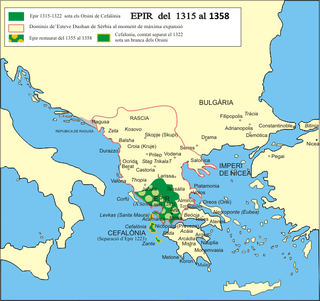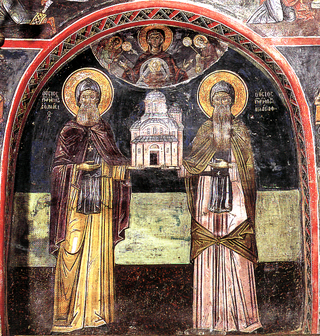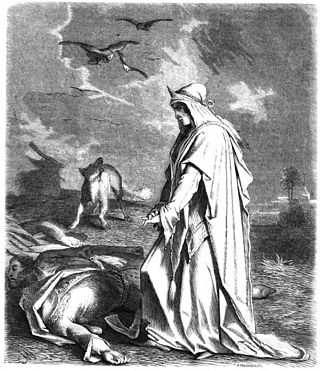Related Research Articles

The Duchy of Athens was one of the Crusader states set up in Greece after the conquest of the Byzantine Empire during the Fourth Crusade as part of the process known as Frankokratia, encompassing the regions of Attica and Boeotia, and surviving until its conquest by the Ottoman Empire in the 15th century.

Theodore I Palaiologos was despot (despotēs) in the Morea from 1383 until his death on 24 June 1407. A son of Emperor John V Palaiologos, Theodore was the first member of the Palaiologos dynasty appointed as the Despot of the Morea, following the final defeat of the rival Kantakouzenos clan, who under John VI Kantakouzenos had attempted to usurp rule of the Byzantine Empire.

Matthew Asen Kantakouzenos or Cantacuzenus was Byzantine Emperor from 1353 to 1357 and later Despot of the Morea from 1380 to 1381.

Nikephoros II Orsini Doukas, was the ruler of Epirus from 1335 to 1338 and from 1356 until his death in 1359.

Simeon Uroš, nicknamed Siniša (Синиша), was a self-proclaimed Emperor of Serbs and Greeks, from 1356 to 1370. He was son of Serbian King Stephen Uroš III and Byzantine Princess Maria Palaiologina. Initially, he was awarded the title of despot in 1346, and appointed governor of southern Epirus and Acarnania in 1347 by his half-brother, Serbian Emperor Stephen Dušan. After Dušan's death in 1355, the Serbian throne passed to Dušan's son Stephen Uroš V, but despot Simeon decided to seize the opportunity in order to impose himself as co-ruler and lord of all southern provinces of the Serbian Empire. That led him to conflict with his nephew in 1356, when Simeon started to expand his control in southern regions of the Empire, trying to take Thessaly and Macedonia. He proclaimed himself Emperor of the Serbs and Greeks, creating a separate state, centered in regions of Thessaly and Epirus, where he ruled until his death in 1370. He was succeeded by his son Jovan Uroš.

Jovan Uroš Nemanjić or John Ouresis Doukas Palaiologos or Joasaph of Meteora, was the ruler of Thessaly from c. 1370 to c. 1373, retiring as a monk for the next half century thereafter. He died in 1422 or 1423.

Maria Angelina Doukaina Palaiologina or Marija Angelina Nemanjić or Anna Maria Angelina Doukaina Palaiologina was a Byzantine Greek-Serbian aristocrat and the self-proclaimed basilissa of Epirus from 1384–85, succeeding the rule of her murdered husband Thomas Preljubović. Maria and her husband were a famed couple as patrons of the arts during Tomo's rule of Ioannina from 1366 to 1384. She is portrayed in the icons.

The Duchy of Neopatras was a principality in southern Thessaly, established in 1319. Officially part of the Kingdom of Sicily, itself part of the Crown of Aragon, the duchy was governed in conjunction with the neighbouring Duchy of Athens, it enjoyed a large degree of self-government. From the mid-14th century, the duchies entered a period of decline: most of the Thessalian possessions were lost to the Serbian Empire, internal dissensions arose, along with the menace of Turkish piracy in the Aegean and the onset of Ottoman expansion in the Balkans. Enfeebled, the Catalan possessions were taken over by the Florentine adventurer Nerio I Acciaioli in 1385–1390. The title of Duke of Neopatras was held by the heir of the King of Sicily.

Nerio I Acciaioli or Acciajuoli was the de facto Duke of Athens from 1385 to 1388, after which he reigned uncontested until his death in 1394. Born to a family of Florentine bankers, he became the principal agent of his influential kinsman, Niccolò Acciaioli, in Frankish Greece in 1360. He purchased large domains in the Principality of Achaea and administered them independently of the absent princes. He hired mercenaries and conquered Megara, a strategically important fortress in the Duchy of Athens, in 1374 or 1375. His troops again invaded the duchy in 1385. The Catalans who remained loyal to King Peter IV of Aragon could only keep the Acropolis of Athens, but they were also forced into surrender in 1388.

Nerio II Acciaioli (1416–1451) was the Duke of Athens on two separate occasions from 1435 to 1439 and again from 1441 to 1451.

Louis Fadrique a Catalan nobleman who was Count of Salona, as well as lord of various other towns in Central Greece from ca. 1365 until his death in 1382. In 1375–1381 he also served as the vicar-general of the twin duchy of Athens and Neopatras.

Anna of Savoy, born Giovanna (1306–1365), was a Byzantine Empress consort, as the second spouse of Andronikos III Palaiologos. She served as regent, with the titles augusta and autokratorissa, during the minority of her son John V Palaiologos from 1341 until 1347. In Byzantium, she was known as Anna Palaiologina, owing to her marriage to Andronikos.
Irene Asanina, was the empress consort of John VI Kantakouzenos of the Byzantine Empire. She is known to have participated in military issues in a degree uncommon for a Byzantine empress. She commanded the garrison of Didymoteicho during the Byzantine civil war of 1341–1347, and organized the defense of Constantinople against the Genoese in 1348, and the forces of John V in 1353.
Helena Kantakouzene was the Empress consort of John V Palaiologos of the Byzantine Empire. She served as Regent during the absence of her son Manuel II in 1393.
Irene Palaiologina was the empress consort of Matthew Kantakouzenos.
Theodora Kantakouzene Megale Komnene was the Empress consort of Alexios IV of Trebizond. Said to be very beautiful, according to the chronicle of Laonikos Chalkokondyles, she was accused by her son, John Megas Komnenos, of having an affair with the protovestiarios of the court of Trebizond; however, other accounts describe her as a faithful and loving wife, who kept the peace between Alexios and his sons. In either case, during her lifetime their son John fled to Georgia and did not return until after Theodora's death.

Helena Kantakouzene was the second wife of David of Trebizond, the last Emperor of Trebizond.
Alexios Angelos Philanthropenos was a Byzantine Greek nobleman who ruled Thessaly from 1373 until c. 1390 with the title of Caesar.

The Lordship of Salona, after 1318 the County of Salona, was a Crusader state established after the Fourth Crusade (1204) in Central Greece, around the town of Salona.
Helena Asanina Kantakouzene was regent of the Lordship of Salona in Frankish Greece from 1382 until its conquest by the Ottoman Empire in 1394 on behalf of her daughter Maria Fadrique.
References
- ↑ Nicol 1968, pp. 160ff..
- ↑ Nicol 1968, p. 161.
- ↑ Nicol 1968, p. 162.
- ↑ Nicol 1968, pp. 163.
- ↑ Alderson, Anthony Dolphin (1956). The Structure of the Ottoman Dynasty [Tav.XXIV]. Clarendon Press.
- ↑ Sakaoğlu, Necdet (2008). Bu mülkün kadın sultanları: vâlide sultanlar, hâtunlar, hasekiler, kadınefendiler, sultanefendiler. Oğlak bilimsel kitaplar (1. baskı ed.). Beyoğlu, İstanbul: Oğlak Yayıncılık. pp. 87–88. ISBN 978-975-329-623-6. OCLC 316234394.
- ↑ Nicol 1968, pp. 161ff..